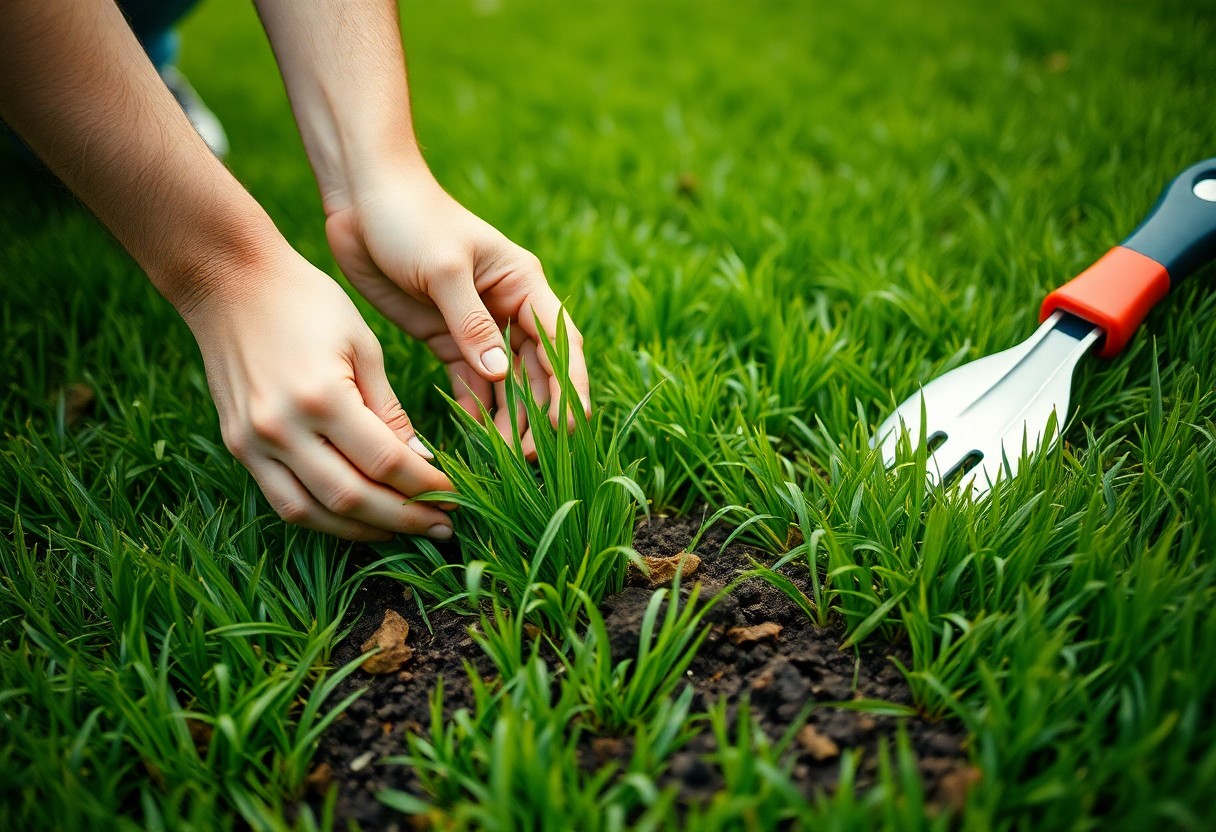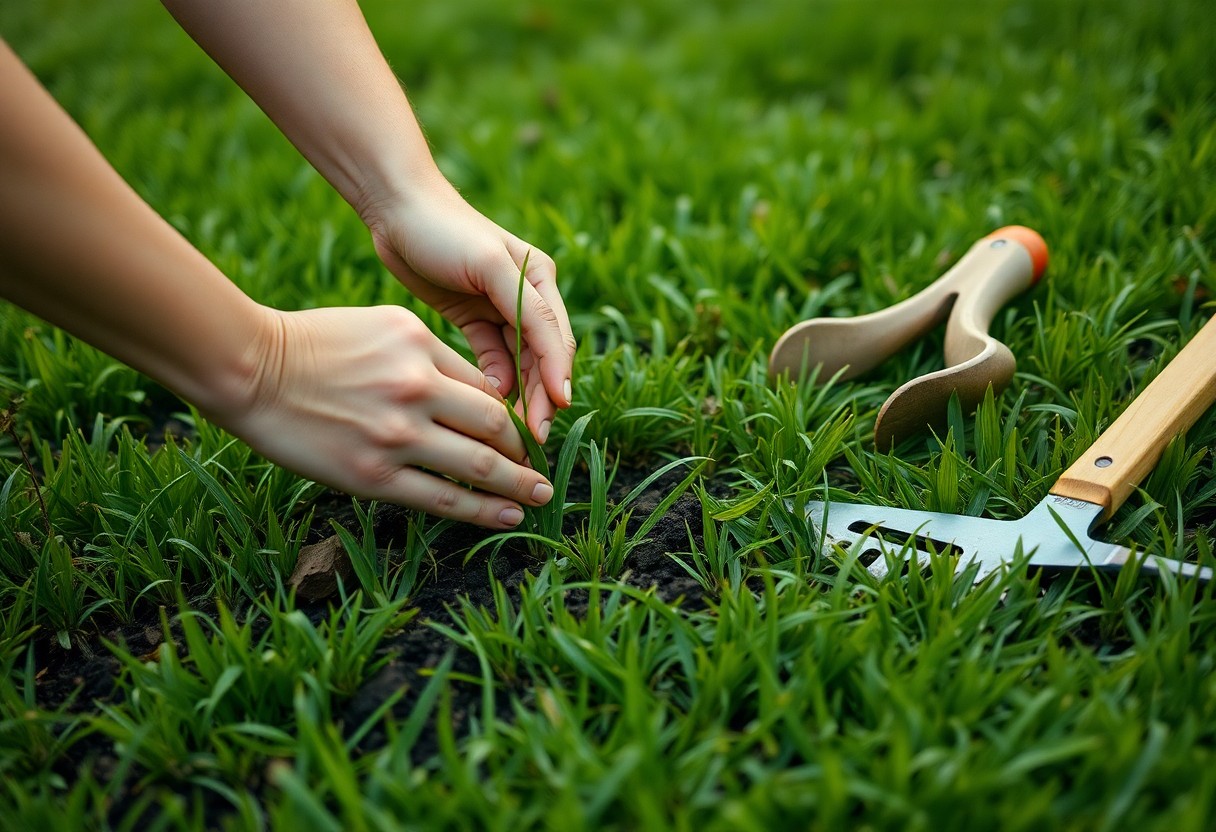Over time, you may find your lawn overtaken by crabgrass, a persistent weed that can ruin the appearance of your yard. Fortunately, you can tackle this issue effectively without relying on harmful chemicals. By implementing a range of natural, eco-friendly methods, you can achieve a healthy, vibrant lawn while preserving the environment. This guide will equip you with practical strategies to eliminate crabgrass for good, ensuring your outdoor space remains stunning and safe for your family and pets.

Key Takeaways:
- Maintain a healthy lawn by ensuring proper mowing, watering, and fertilization practices to create an environment less conducive to crabgrass growth.
- Utilize natural methods such as manually pulling out crabgrass or employing mulch and dense planting to suppress its growth.
- Consider planting a thick and diverse lawn that can outcompete crabgrass for resources, reducing its chances of establishing itself.
Understanding Crabgrass
For those looking to maintain a healthy lawn, understanding crabgrass is imperative. This invasive weed thrives in various conditions, swiftly overtaking your garden, especially during the warmer months. Recognizing its characteristics and growth patterns will empower you to take effective measures against it.
What is Crabgrass?
Assuming you’ve encountered this pesky weed, crabgrass is an annual grass, often sprouting in disturbed soil and lawns. It typically presents broad, flat leaves with a sprawling growth habit, making it highly competitive against desirable grass species. Understanding its life cycle will aid in your battle against it.
Factors Contributing to Crabgrass Growth
Some factors contribute significantly to the growth of crabgrass in your lawn. Here are a few key elements:
- Moisture—Excess moisture promotes seed germination.
- Soil Compaction—Compacted soil creates ideal conditions for proud crabgrass growth.
- Temperature—Warm soil temperatures trigger seed sprouting.
- Sunlight—Full sun helps crabgrass flourish.
Any of these conditions can contribute to a crabgrass infestation.
What you may not realize is that some environmental factors can exacerbate your crabgrass problems. Additionally, poor lawn health, such as sparse grass, creates an open environment for crabgrass to emerge. Here are further considerations:
- Weeded Areas—Bare patches invite crabgrass.
- Inconsistent Watering—Irregularity can weaken your grass.
- Low Nutrient Levels—Nutrient-deficient lawns are more susceptible.
Any of these factors can dramatically increase the likelihood of crabgrass establishment in your yard.
Prevention Strategies
Any successful battle against crabgrass begins with effective prevention strategies. By fostering a dense, healthy lawn, you can outcompete the crabgrass for sunlight, nutrients, and moisture. This involves using proper lawn care practices and maintaining optimal mowing techniques to keep your grass thriving and resilient against invasive species.
Lawn Care Best Practices
Best practices in lawn care include regular watering and fertilizing to promote a thick, lush lawn. You should aim to Water deeply but infrequently, helping your grass develop deeper roots. Additionally, using organic fertilizers can enhance soil health without the negative effects of chemicals, allowing your lawn to flourish.
Optimal Mowing Techniques
Best mowing techniques can significantly affect the overall health of your lawn. Keeping your mower blades sharp ensures clean cuts that minimize stress on your grass. Additionally, mow at the recommended height for your grass type, as taller blades provide shade to the soil, helping to reduce crabgrass germination.
Plus, mowing your grass to the appropriate height not only promotes a healthier lawn but also deters crabgrass from taking hold. By keeping your grass at a height of at least 3 inches, you enable it to better shade the soil, thereby reducing sunlight availability for crabgrass seeds. Furthermore, consider varying your mowing pattern each time you mow, which can prevent the soil from becoming compacted and promote even growth, making your lawn less inviting to pesky weeds.
Natural Control Methods
Unlike chemical solutions, which can harm your garden and local ecosystem, natural control methods for getting rid of crabgrass are sustainable and environmentally friendly. By adopting these methods, you can nurture your lawn while effectively managing crabgrass populations. With patience and persistence, you can maintain a healthy yard that thrives without the use of harsh chemicals.
Hand Pulling and Manual Removal
Little attention to detail can make a big difference when you hand pull crabgrass. Make sure to remove the entire root to prevent it from growing back. This method is labor-intensive, but it’s effective and safe for biodiversity in your garden.
Using Boiling Water or Vinegar
Manual methods like using boiling water or vinegar are effective in eradicating crabgrass naturally. Boiling water is a non-selective herbicide, meaning it will affect any plant it touches, so be careful to target only the crabgrass. Vinegar, with a high concentration of acetic acid (20% or more), can also kill the plant effectively. However, be cautious as it may harm surrounding plants if not applied carefully. Use these methods on sunny days for the best results.
With these methods, you can manage crabgrass effectively while ensuring that your garden remains healthy. Boiling water is a straightforward and quick solution; simply pour it directly onto the crabgrass, ensuring you cover the base and roots. On the other hand, using vinegar works best when applied directly to the leaves, as it can penetrate and destroy the plant’s cellular structure. These methods are safe for your environment, but you need to take care that they don’t affect desired plants. Regular application during the growing season can help keep your lawn crabgrass-free.
Soil Management
To effectively combat crabgrass, it’s important to focus on proper soil management. Healthy soil serves as the foundation for your lawn, encouraging the growth of strong, competitive grass while suppressing unwanted weeds. By implementing strategies such as aeration, regular testing, and organic amendments, you can create an environment that naturally deters crabgrass and promotes a thriving lawn ecosystem.
Improving Soil Health
Assuming your soil is well-managed, you’ll find it more resilient against crabgrass invasions. Enhancing soil health involves balancing pH levels, ensuring adequate nutrients, and promoting microbial activity. This can be achieved through regular soil testing and by adding the necessary amendments, which will create a robust environment for your grass to thrive.
Compost and Mulch Benefits
Little do most people know, compost and mulch are exceptional allies in your fight against crabgrass. By enriching the soil with organic matter and retaining moisture, compost improves your grass’s ability to grow thick and strong, while mulch acts as a barrier to weed growth. Together, they enhance soil structure and nutrient availability.
Compost provides an abundance of nutrients, helping your grass develop a deep root system that makes it more resistant to weeds like crabgrass. Furthermore, when applied as a top dressing, compost manages soil moisture, which keeps your turf healthy during dry spells. On the other hand, mulch offers a natural weed suppression mechanism by blocking sunlight and hindering weed seeds from germinating. Incorporating these organic amendments into your lawn care routine will strengthen your grass and create less favorable conditions for unwanted intruders.
Alternative Natural Remedies
Despite the challenges posed by crabgrass, there are numerous effective natural remedies that can help you regain control of your lawn without resorting to harsh chemicals. By utilizing these eco-friendly options, you can promote a healthier lawn that thrives while naturally keeping undesirable weeds at bay.
Corn Gluten Meal
Remedies such as corn gluten meal serve as a natural pre-emergent herbicide, preventing crabgrass seeds from germinating. By applying it to your lawn before crabgrass season, you create a barrier that inhibits growth, all while enriching your soil with beneficial nutrients.
Other Natural Herbicides
Any alternative options can effectively combat crabgrass, including vinegar, salt, and boiling water. These natural herbicides create an inhospitable environment for crabgrass while minimizing harm to your lawn.
Natural herbicides can be quite effective for on-the-spot treatments, targeting existing crabgrass without disrupting your entire lawn ecosystem. For instance, using vinegar, which is high in acetic acid, can desiccate the leaves of the crabgrass, while sprinkling salt can dehydrate it. Boiling water effectively burns the plant, making it an accessible method for small patches. Always conduct tests on small areas first, as these remedies can also affect desirable plants if not used carefully.

Long-term Maintenance
All successful lawn care requires consistency to keep your grass healthy and protect it from pesky invaders like crabgrass. Regularly assessing your lawn’s health, implementing proper watering techniques, and maintaining soil fertility will ensure that your grass remains robust and capable of outcompeting weed growth. Balancing your lawn’s needs with appropriate care will ultimately lead to a beautiful yard.
Seasonal Lawn Care Tips
One effective way to ensure a thriving lawn is by following seasonal care tips. Focus on:
- Adjusting your mower height for optimal growth
- Applying mulch for moisture retention
- Fertilizing according to seasonal needs
- Overseeding to fill bare patches
Any attention to these seasonal strategies will significantly enhance your lawn’s resilience against crabgrass.
Routine Monitoring Strategies
Even with great care, staying vigilant about your lawn’s health is imperative. Periodically check for any signs of crabgrass emergence and assess overall grass growth. Timely detection allows for faster intervention, helping you maintain a lush lawn. By regularly walking through your yard and observing any changes, you can identify conditions that favor crabgrass development, enabling you to take action before problems escalate.
Routine checks should focus on moisture levels, grass height, and weed presence. Inspect weed populations to determine their growth patterns and effectively plan your maintenance schedule. Implementing a schedule for monitoring your lawn’s health will improve your chances of addressing potential issues in advance, keeping your yard thriving and vibrant.
To wrap up
So, by implementing these natural strategies to eliminate crabgrass, you can achieve a healthier lawn without relying on chemicals. Focus on maintaining the right mowing height, practicing proper watering techniques, and fostering healthy soil to support your desired grass. Additionally, consider using hand-pulling and mulch to further combat this stubborn weed. By taking these steps, you can create an environment that deters crabgrass and promotes a thriving, lush lawn for years to come.
FAQ
Q: What is crabgrass and why is it considered a weed?
A: Crabgrass is a type of annual grassy weed that commonly invades lawns and gardens. It spreads quickly, often choking out desired grasses and plants by competing for nutrients, water, and sunlight. Its ability to thrive in a variety of conditions makes it a persistent problem for many gardeners and homeowners.
Q: What are some natural methods to effectively get rid of crabgrass?
A: Natural methods for eliminating crabgrass include maintaining healthy soil through regular aeration, overseeding your lawn with desirable grass types, and practicing proper mowing techniques. Mulching around garden beds can also suppress crabgrass growth, as well as using vinegar or boiling water directly on the weeds as non-selective herbicides.
Q: Is there a best time of year to tackle crabgrass?
A: Early spring is the ideal time to address crabgrass. This is when it begins to germinate, usually when soil temperatures reach around 55°F for a few consecutive days. By applying pre-emergent measures, such as corn gluten meal or other natural barriers, you can prevent the seeds from sprouting.
Q: How can I prevent crabgrass from coming back after I’ve eliminated it?
A: To prevent the re-emergence of crabgrass, focus on maintaining a dense and healthy lawn. Regularly fertilize and water your grass to keep it vigorous and competitive. Additionally, regularly mow your lawn at the appropriate height for your grass type, as taller grass can compete better against crabgrass.
Q: Are there any cultural practices that can help control crabgrass naturally?
A: Yes, cultural practices such as proper lawn care, including aeration, overseeding, and proper irrigation, can significantly help control crabgrass. Establishing a strong, thick lawn through these practices minimizes the opportunity for crabgrass to take hold. Consider rotating your lawn maintenance strategies to keep it resilient against invasive species.
